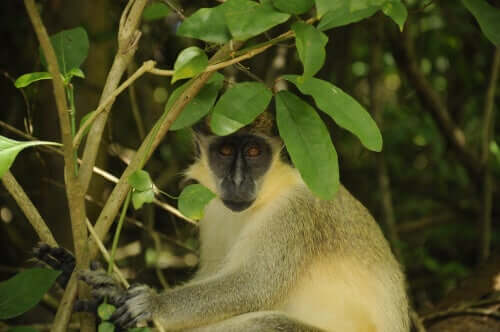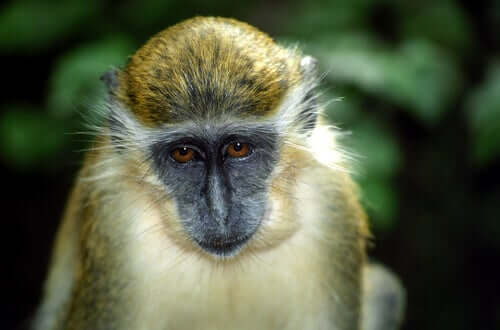Green Monkeys and Their Anti-Drone Alarm


Written and verified by the vet Eugenio Fernández Suárez
Green monkeys are low-key, little known primates. Despite their enormous interest and historical importance, they can still surprise us. A new study just revealed how these animals have their own anti-drone alarm.
Green monkeys and drones
Drones, the unmanned, aerial vehicles have become a real problem. Not only to humans but also to wildlife. The stress caused by these devices in wild animals is quite considerable, and this is very evident to anyone who studies them.
The best-known example of the dangers brought about by this form of technology is the case of a video of a bear in the snow. The video went viral right after its release. In it, a bear’s young tries to climb back up to reach their mother and slides back down as the mama bear motions to swat at the drone.

Moreover, it seems that bears are not the only animals who are bothered by these devices. Green monkeys consider them a nuisance and feel threatened by them so they developed a built-in anti-drone alarm of their own.
This is not a new trait when it comes to the various primates of the genus Chlorocebus. Most of them are well known for their ability to develop an alarm for every predator that’s after them. They have all sorts of strategies to deal with these threats –and get rid of them.
How does the anti-drone alarm works?
The incredible communication skills of this primate definitely deserve to be studied all by themselves. Commonly, when they hear a leopard, one of their alarms goes off and they quickly climb up onto a tree. In a similar fashion, they look up immediately when they hear an eagle go by. Furthermore, when they hear a snake they quickly get up on their two legs.
There are no studies on this kind of behavior in all species of the genus Chlorocebus, and their alarms may differ.
Recently, primatologist Julia Fischer led an interesting new study. In it, people flew drones near a group of 80 green monkeys (Chlorocebus sabaeus). The predator reaction of this species still hadn’t been studied. Fischer found that the alarm they used was very similar to the one made by Vervet monkeys (Chlorocebus pygerythrus). Their reaction to their predators was very similar when in their presence.

Furthermore, she recorded the warning calls of these primates and then reproduced them in the presence of 16 of these monkeys. These reacted similarly after hearing the recordings.
So, this could indicate that the structure of the alarm call is innate. Even though it’s also been shown that, in order to improve it, younger monkeys must learn from the older ones.
There are similar studies, such as the one conducted with the green monkeys of the Barbados Islands, isolated for almost four centuries from most of their predators. Researchers found the monkeys there also recognize these alarm calls.
Green monkeys are low-key, little known primates. Despite their enormous interest and historical importance, they can still surprise us. A new study just revealed how these animals have their own anti-drone alarm.
Green monkeys and drones
Drones, the unmanned, aerial vehicles have become a real problem. Not only to humans but also to wildlife. The stress caused by these devices in wild animals is quite considerable, and this is very evident to anyone who studies them.
The best-known example of the dangers brought about by this form of technology is the case of a video of a bear in the snow. The video went viral right after its release. In it, a bear’s young tries to climb back up to reach their mother and slides back down as the mama bear motions to swat at the drone.

Moreover, it seems that bears are not the only animals who are bothered by these devices. Green monkeys consider them a nuisance and feel threatened by them so they developed a built-in anti-drone alarm of their own.
This is not a new trait when it comes to the various primates of the genus Chlorocebus. Most of them are well known for their ability to develop an alarm for every predator that’s after them. They have all sorts of strategies to deal with these threats –and get rid of them.
How does the anti-drone alarm works?
The incredible communication skills of this primate definitely deserve to be studied all by themselves. Commonly, when they hear a leopard, one of their alarms goes off and they quickly climb up onto a tree. In a similar fashion, they look up immediately when they hear an eagle go by. Furthermore, when they hear a snake they quickly get up on their two legs.
There are no studies on this kind of behavior in all species of the genus Chlorocebus, and their alarms may differ.
Recently, primatologist Julia Fischer led an interesting new study. In it, people flew drones near a group of 80 green monkeys (Chlorocebus sabaeus). The predator reaction of this species still hadn’t been studied. Fischer found that the alarm they used was very similar to the one made by Vervet monkeys (Chlorocebus pygerythrus). Their reaction to their predators was very similar when in their presence.

Furthermore, she recorded the warning calls of these primates and then reproduced them in the presence of 16 of these monkeys. These reacted similarly after hearing the recordings.
So, this could indicate that the structure of the alarm call is innate. Even though it’s also been shown that, in order to improve it, younger monkeys must learn from the older ones.
There are similar studies, such as the one conducted with the green monkeys of the Barbados Islands, isolated for almost four centuries from most of their predators. Researchers found the monkeys there also recognize these alarm calls.
All cited sources were thoroughly reviewed by our team to ensure their quality, reliability, currency, and validity. The bibliography of this article was considered reliable and of academic or scientific accuracy.
Burns-Cusato, M., Cusato, B., & Glueck, A. C. (2013). Barbados green monkeys (Chlorocebus sabaeus) recognize ancestral alarm calls after 350 years of isolation. Behavioural processes, 100, 197-199.
This text is provided for informational purposes only and does not replace consultation with a professional. If in doubt, consult your specialist.








